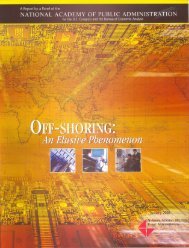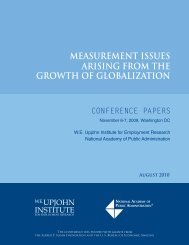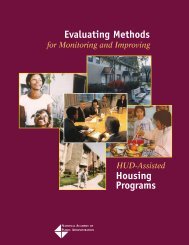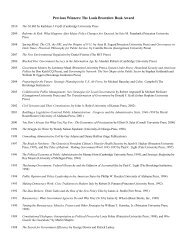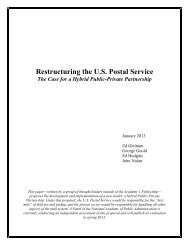High-Performance Partnerships - National Academy of Public ...
High-Performance Partnerships - National Academy of Public ...
High-Performance Partnerships - National Academy of Public ...
You also want an ePaper? Increase the reach of your titles
YUMPU automatically turns print PDFs into web optimized ePapers that Google loves.
RESULTS<br />
chapter four<br />
Healthy Families has involved the College <strong>of</strong> William and<br />
Mary to evaluate the program from its initial planning<br />
phase. We knew that every dollar allocated to evaluation<br />
would be one less dollar spent on services to families.<br />
We also knew that the organization’s future<br />
depended on our ability to secure ongoing funding that<br />
would only be available if we had documented results.<br />
During the first four years, Healthy Families spent<br />
approximately $100,000 on evaluation. It was well<br />
worth the investment. Today, the partnership receives<br />
more than $2.7 million in city funding, $1 million a year<br />
in donations and in-kind and redirected resources from<br />
community partners, and approximately $850,000 in federal<br />
reimbursements. We believe that all <strong>of</strong> these<br />
resources are a direct result <strong>of</strong> the investment made in<br />
conducting a strong evaluation and our ongoing commitment<br />
to collect qualitative and quantitative information.<br />
Debbie Russell, Healthy Families Partnership (Hampton)<br />
its successes. Investing in an evaluation expert<br />
is money well spent, and there are several<br />
options to do this. A central entity that routinely<br />
collects community information may be<br />
willing to provide data analysis. Examples<br />
include a university, district planning commission,<br />
foundation, or national organization<br />
adept at research and evaluation. Another<br />
option is to build evaluation costs into a partnership’s<br />
initial budget.<br />
4. Reward stakeholders for providing accurate<br />
and timely data.<br />
Data come at a cost. A partnership must not<br />
be afraid to incentivize positive behavior that<br />
contributes to its overall effectiveness. This<br />
includes accurate and timely data collection<br />
and reporting.<br />
THE COST OF MEASURING RESULTS<br />
Data collection can be very expensive, and<br />
many initiatives do not have vast resources.<br />
Yet the effectiveness <strong>of</strong> the entire effort may be<br />
questioned without adequate evaluation. The<br />
partnership faces a dilemma: deliver more<br />
units <strong>of</strong> service or reduce the number to evaluate<br />
the effectiveness <strong>of</strong> those that are.<br />
The Strategies<br />
First and foremost, the design lab participants<br />
recommend that other partnerships “just do<br />
it.” Continuing to support an unproductive<br />
program is unwise. Neither the public nor<br />
nonpr<strong>of</strong>it sector has such an abundance <strong>of</strong><br />
resources to permit prolonged inefficiency.<br />
Accountability to taxpayers, donors, and other<br />
funders requires an effective evaluation<br />
process. Given limited resources, how can a<br />
cross-sector partnership evaluate program<br />
effectiveness and communicate the results?<br />
1. Get a partner with evaluation capability.<br />
<strong>Partnerships</strong> generally include service delivery<br />
agencies. These are essential, but so is program<br />
evaluation. <strong>Partnerships</strong> can recruit a<br />
member with this evaluative capability, such as<br />
a university, foundation, or research organization.<br />
This is similar to a strategy <strong>of</strong>fered for<br />
the prior challenge.<br />
2. Develop the capacity for self-evaluation.<br />
An internal audit may not be as universally<br />
accepted as an independent evaluation, but it<br />
provides the opportunity to make midcourse<br />
adjustments. It is not critical for the partnership<br />
to have an optimal evaluation methodology,but<br />
it is essential that an evaluative component<br />
exists from the outset.<br />
3. Just do it.<br />
Resources may generally be limited but, again,<br />
a partnership should fund program evaluation<br />
in its initial budget. Showing early results<br />
could help to secure second phase funding or<br />
constituent support, making this line item a<br />
worthwhile expenditure. Further, midcourse<br />
corrections without supporting data would be<br />
hazardous at best.<br />
72 Powering the Future: <strong>High</strong>-<strong>Performance</strong> <strong>Partnerships</strong>




